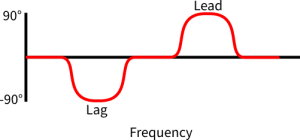Lead-lag controls or compensators are pieces of programming in control systems that improve frequency response.
- A lead control can increase a system’s stability or its response speed.
- A lag control can reduce steady-state errors.
Different combinations change output in different ways.
A note on terminology: The terms controller and compensator have several different meanings. Some engineers and manufacturers use these terms interchangeably. Others differentiate between the two. Some designers use controller to only refer to physical hardware — and compensator to refer to the algorithms that the hardware runs. Still others use compensator to refer only to filters that compensate for potential control-loop deficiencies. These add the exact number of variables present back to the system (while in contrast, controllers add a different number of variables back).

Regardless of terminology differences, design engineers use controllers and compensators to improve frequency response. Lags and leads apply to phases. Lead is a way to shift the phase angle of the output curve before the input curve. Lag is a way to shift the phase angle of the output curve after the input curve. So, lead-lag controllers do both. Tip: when selecting lead-lag controls, determine what level of closed-loop performance the machine needs. An appropriate lead-lag controller (along with the other components in the system) should satisfy design specifications.
Lead-lag controllers require a closed-loop operation. They use system feedback as part of their algorithms. This adds system complexity, but (as mentioned) improves overall system frequency response. This is especially useful for addressing noise, vibration and resonant frequency problems. Read FAQ: Aren’t heat and noise common stepper motor problems? for more information.
When determining if a lead-lag controller is right for a given system, ask:
- Is a closed-loop system appropriate for the design, or is it overkill? Here, remember that better controls come at slightly higher cost.
- Are their machine problems such as vibration that a lead-lag controller can fix? If there are such problems, determine if a lead-lag controller is the best solution.
- Does the machine need off-the-shelf functionality? Lead-lag controllers suit specific systems, so require custom setup.
For more information on lead-lag, read:
Matlab Control Tutorials, Extras: Designing Lead and Lag Compensators


Leave a Reply
You must be logged in to post a comment.